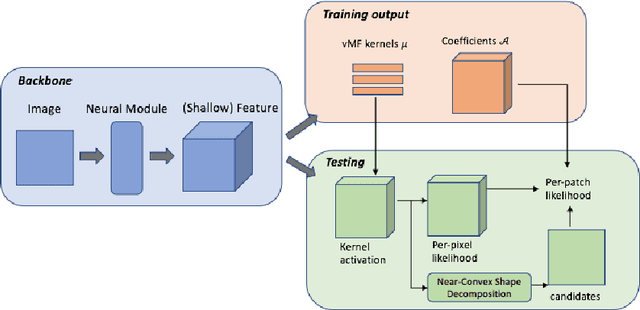Alex Szalay
A Light-weight Interpretable CompositionalNetwork for Nuclei Detection and Weakly-supervised Segmentation
Oct 26, 2021



Abstract:The field of computational pathology has witnessed great advancements since deep neural networks have been widely applied. These deep neural networks usually require large numbers of annotated data to train vast parameters. However, it takes significant effort to annotate a large histopathology dataset. We propose to build a data-efficient model, which only requires partial annotation, specifically on isolated nucleus, rather than on the whole slide image. It exploits shallow features as its backbone and is light-weight, therefore a small number of data is sufficient for training. What's more, it is a generative compositional model, which enjoys interpretability in its prediction. The proposed method could be an alternative solution for the data-hungry problem of deep learning methods.
Baryon acoustic oscillations reconstruction using convolutional neural networks
Feb 24, 2020



Abstract:Here we propose a new scheme to reconstruct the baryon acoustic oscillations (BAO) signal, with key cosmological information, based on deep convolutional neural networks. After training the network with almost no fine-tuning, in the test set, the network recovers large-scale modes accurately: the correlation coefficient between the ground truth and recovered initial conditions still reach $90\%$ at $k \leq 0.2~ h\mathrm{Mpc}^{-1}$, which significantly improves the BAO signal-to-noise ratio until the scale $k=0.4~ h\mathrm{Mpc}^{-1}$. Furthermore, our scheme is independent of the survey boundary since it reconstructs initial condition based on local density distribution in configuration space, which means that we can gain more information from the whole survey space. Finally, we found our trained network is not sensitive to the cosmological parameters and works very well in those cosmologies close to that of our training set. This new scheme will possibly help us dig out more information from the current, on-going and future galaxy surveys.
Model-Based Event Detection in Wireless Sensor Networks
Jan 25, 2009



Abstract:In this paper we present an application of techniques from statistical signal processing to the problem of event detection in wireless sensor networks used for environmental monitoring. The proposed approach uses the well-established Principal Component Analysis (PCA) technique to build a compact model of the observed phenomena that is able to capture daily and seasonal trends in the collected measurements. We then use the divergence between actual measurements and model predictions to detect the existence of discrete events within the collected data streams. Our preliminary results show that this event detection mechanism is sensitive enough to detect the onset of rain events using the temperature modality of a wireless sensor network.
 Add to Chrome
Add to Chrome Add to Firefox
Add to Firefox Add to Edge
Add to Edge